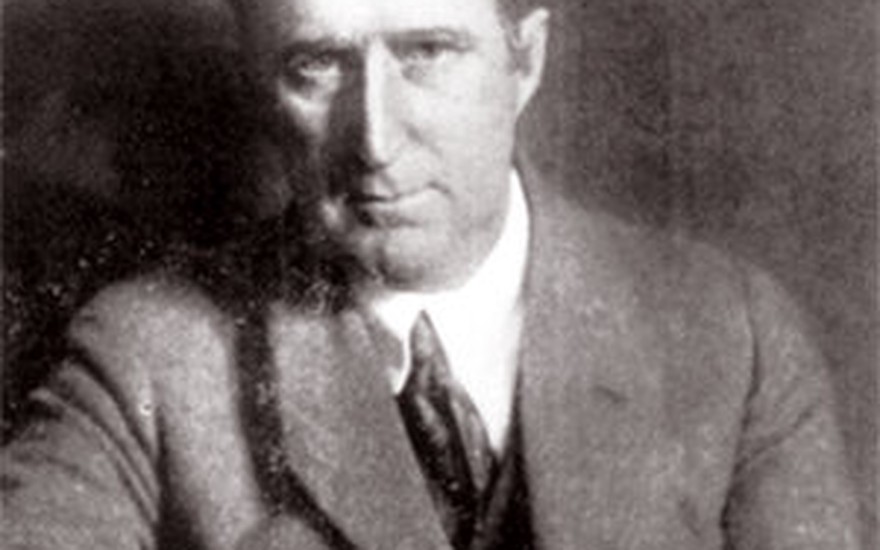
Frank Marshall - from Wikipedia
The Marshall Defence, 1 d4 d5 2 c4 Nf6: Myths and Realities (part 1)
Myth 1: 'just bad'The Marshall Defence, 1 d4 d5 2 c4 Nf6
Introduction
Against the Queen's Gambit, 1 d4 d5 2 c4, the move 2...Nf6 is named after the long-time American champion Frank Marshall (1877-1944). Significant games with this opening were played in the 1920s, during the 'hypermodern' era. As in the Gruenfeld Defence (1 d4 Nf6 2 c4 g6 3 Nc3 d5) Black aims to tempt White into overextension in the centre.
There are at least three better second moves than 2...Nf6. But the extent to which the Marshall Defence has been despised by theory is peculiar. Its unjustly awful reputation even helps to make it into a handy secret weapon.
Having examined some Marshall myths, this series of posts also aims to indicate some realities.
I am not offering a repertoire with the Marshall Defence. I don't recommend relying on it. But readers who like to experiment can use this material to give 2...Nf6 a try.
Acknowledgements
Many years ago Rick Kennedy generously shared with me his research on the Marshall Defence. His article 'Alekhine versus Marshall’s 1 d4 d5 2 c4 Nf6!?', chesscafe.com (March 2010) remains fundamental for the history of this opening. That article was slightly revised from his 'Aljechin im Kampf mit Marshalls 2...Sf6', in Kaissiber 27 (2007), 35-39. It was justly praised by Michael Goeller in 'Marshall's 1 d4 d5 2 c4 Nf6!?' (The Kenilworthian blog, 26 March 2010). I am very grateful to Rick Kennedy as well as to the editor of Kaissiber, Stefan Bücker, for sharing ideas and information with me. My coverage does not attempt completeness; all deficiencies are mine alone.
Myth 1: The Marshall Defence is 'just bad'
The Marshall Defence is just bad, and is only played by very inexperienced players.
Graham Burgess in G. Burgess und S. Pedersen, The Queen’s Gambit for the Attacking Player (Batsford, 1994)
This is hardly an isolated opinion. An authoritative theoretician recently wrote:
This is a bad version of the Grunfeld for Black. Black loses control over the centre and does not get the kind of pressure against the centre that Black gets in the Grunfeld systems as he doesn't have ...Nxc3 that Black has in Grunfeld when White plays e4.
Srinath Narayanan, Lifetime Repertoires: The Catalan (Chessable, 2021)
And that seems to be a long-held consensus:
This Marshall Defense surrenders the center -- and favors White
Lev Alburt, 'Time, Anyone?' Chess Life column 'Back to Basics' (October, 2009, p. 38)
Again:
It’s a classic example of an opening rejected by the chess establishment that’s very popular at lower levels. I think nine times out of ten the Marshall Defense is played out of ignorance. Some players haven’t studied queen pawn openings at all, or don’t understand the virtue of fortifying your center pawn with a pawn. Some players are sloppy with their move order. Even on the database, the Marshall is played very poorly and the percentages are overwhelmingly in White’s favor.
Joel Benjamin, 'GM Joel on the Marshall' (US Chess Federation blog post, 22 February 2008)
Benjamin's opinion of the opening had, if anything, worsened over the past couple of decades:
This opening pops up in a lot of junior play and in simuls. It is a hypermodern approach to the QGD, where Black allows White to build a big centre. Unfortunately the centre proves to be quite strong. 1 d4 d5 2 c4 Nf6 3 cxd5 Nxd5. White should avoid 4 e4 Nf6 5 Nc3 e5!) and play instead 4 Nf3! Bf5 5 Nbd2 followed by e4. If 5 ..Nf6 6 Qb3+=
Joel Benjamin and Eric Schiller, Unorthodox Openings (Batsford, 1987)
Well, Benjamin and Schiller give us a line to work with. But maybe 2...Nf6 is so bad that there's no need even to bother with that?
I am ruling out 2...Nf6?! which does nothing for the pawn centre and is obviously best met by 3 cxd5.
Chris Ward, Play the Queen's Gambit (Everyman, 2006)
Lars Schandorff's Playing the Queen's Gambit (Quality Chess, 2009) took Ward's approach a step further by leaving the Marshall Defence completely unmentioned.
Or maybe only lower-rated players should look at it?
Often played by beginners but very weak
Tim Harding and Leonard Barden, Chess Openings for the Average Player (Batsford, 1987)
Still in doubt? Here is the view of one of the leading 21st-century theoreticians of queen's pawn openings:
2...Nf6?! is poor.
Boris Avrukh, 1 d4 Volume 1 (Quality Chess, 2008)
It is safe to conclude that the Marshall Defence is
generally regarded as a dubious variation.
Gary Lane, 'Forget Me Not', chesscafe.com column 'Opening Lanes', March 2010.
Indeed, that is exactly how it is 'officially' defined, in The Oxford Companion to Chess by David Hooper and Kenneth Whyld (2nd edition, Oxford University Press 1996):
a dubious variation
So: refuting the Marshall Defence must be straightforward.
Or... perhaps it isn't?
The sources quoted above offer various different ways of meeting the Marshall Defence. All of them have one thing in common: they assume that 2...Nf6 can be easily dismissed. Often this means that Black's best tries are omitted from the analysis. We'll get to that in subsequent posts.
Historical views
Chess opening theory usually progresses with time. Yet, in this case, older opinions cast doubt on the prevailing orthodoxy. This time I quote two world champions on the move 2...Nf6:
An unusual but by no means bad move
Max Euwe, annotation to the game Euwe-Bogoljubow, Kagans neueste Nachrichten 8. Jahrgang (1928)
Marshall's try, 1 d4 d5 2 c4 Nf6. I don't believe that the move 2...Nf6 can be refuted by 3 cxd5... though it hardly has any independent value, since after 3 Nc3 (or 3 Nf3) Black has nothing better than transposing to the old variations.
Alexander Alekhine, 'The Theoretical Significance of the Baden-Baden Tournament', in Kagans neueste Nachrichten, 5. Jahrgang (1925), 405.
The Marshall Defence in high-level games
Another fact that may cast doubt on the almost unanimous dismissal of the Marshall Defence is that it has been played by a number of strong grandmasters. Pavel Ponkratov, a 2600-level GM, plays it regularly.
Not only that, but it is as though their opponents had taken Alekhine's comment to heart: they tend not to take up the challenge with 3 cxd5.
A glance at the Lichess database reveals, for instance:
Grischuk-Ponkratov, chess.com 2022: 3 Nf3
Van Foreest-Van Wely 2019 (blitz): 3 Nf3
Karpov-Ivanchuk, Cap d'Agde 2012: 3 Nc3
Huebner-Sadler, Bundesliga 2002: 3 Nc3
van Wely-Timman 1998: 3 Nc3
Shirov-Bareev, Biel 1991: 3 Nf3
And when one of Ponkratov's strongest opponents recently dared to take the pawn, what happened?
3 cxd5 Bf5 4 Nf3 Nxd5 5 Nc3 e6 6 g3 Nb4 7 e4 Bg4 and Black was fine.
Conclusion
Without having done any analysis yet, it seems reasonable to conclude provisionally that the Marshall Defence is not 'just bad', nor is it played only by 'very inexperienced players' (as Burgess claims). Unlike the hapless amateurs mentioned by Joel Benjamin, the world-class players listed above were unlikely to have been stumbling around, entirely unprepared as early move two and barely aware of the need to control the centre.
It should be mentioned that Alekhine subsequently changed his mind, writing in My Best Games of Chess, 1924-1937 (1939) that 2...Nf6 'cannot be recommended'.
And My Fifty Years of Chess (1942) by none other than Frank Marshall calls 2...Nf6 'an inferior move which permits White to gain control of the center'. Marshall's view of his own line may seem damning. However, it is possible that this book was not written by the ageing Marshall, but by a ghostwriter, probably Fred Reinfeld (see Edward Winter's Chess Notes items 341, 1273, 9834, gathered here).
But more on Marshall's exploits in the next post.
I'll continue this work as time permits. Please 'like' this post if you found it interesting: this is encouraging! If you have any sources that comment on the Marshall, please mention them in the forum. Questions also very welcome there.
More blog posts by Minckwitz

Review: Max Euwe's Best Games by Jan Timman
Games of lesser-studied world champions part 1
Review: The Perfect Pirc-Modern by Viktor Moskalenko
This is a review by FM James Vigus of Moskalenko's The Perfect Pirc-Modern
Review: Some instructional and training works
Review by FM James Vigus of recent training/calculation books